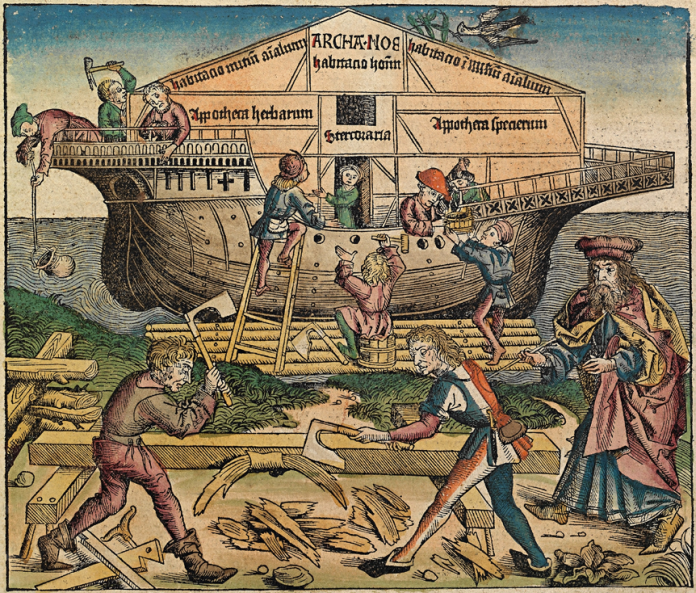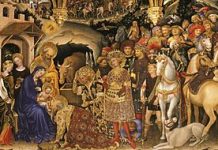Noah (2014)
Directed by Darren Aronofsky
Written by Darren Aronofsky, Ari Handel
Has there ever been a successful adaptation of an episode from the Bible in a film? Probably not, and for a good reason. The artistic genius of the ancient Jews was primarily literary, not in painting, sculpture or architecture. Hence the scenes described in the Bible do not translate easily into images. Who could possibly capture on canvas or film the visions of Ezekiel or of Saint John on Patmos? Perhaps God’s ban on images was not only to avert the danger of idolatry, but also to prevent the Jews from producing banalities, a possibility that movie directors who have taken up the challenge all too often realize.
There have been hosts of movies based on the Bible. Each such film confronts two ineluctable difficulties. The first is a wide-spread conviction that the historical-critical method of biblical exegesis has destroyed the credibility of the biblical text. Nowhere is this challenge stronger than in the academic examination of the mythical elements in the Pentateuch in general and Genesis in particular. Hence, “It’s all myth,” is the general attitude of a public whose biblical studies are limited to an occasional magazine article or television special, “myth” being accepted as a synonym for “fable.”
The second difficulty is the limited scope of the biblical narrative. Human psychology, the stuff of modern drama, is secondary to an account of God’s interaction with mankind, with the chosen people or with an individual. For instance, the story of the flood takes its meaning from its final section in which a new covenant is entered into between God and, through Noah, the entire human race, a covenant that is one in a series begun with Adam and continuing on with Moses and David, each of which has its completion in the definitive covenant established by Jesus.
Antiquarians inform us that flood stories were common in ancient Mesopotamia. There, unlike Egypt where the waters of the Nile were beneficent, the floods of the Tigris and the Euphrates periodically devastated whole regions, and it would have seemed that the entire world was under water. The Babylonian Gilgamesh Epic describes a great flood, in which the gods decide to destroy mankind. Forewarned, Uta-napishti builds a boat and so survives:
Everything I owned I loaded aboard: All the silver I owned I loaded aboard, All the gold I owned I loaded aboard, All the living creatures I had I loaded aboard.
I sent on board all my kith and kin, The beasts of the field, the creatures of the wild, And members of every skill and craft.
After the waters have receded, Uta-napishti offers a sacrifice to the gods: The gods did smell the savour, The gods did smell the savour sweet, The gods gathered like flies around the man making sacrifice.[1]
Living in an age in which science has formed the imagination, we are all more or less materialists, all too ready to dismiss primitive world views without a hearing. “Philosophy is dead. Philosophy has not kept up with modern developments in science, particularly physics.”[2] The implications of this remark are far reaching. It asserts that no one of the past, not Plato or Aristotle, not Augustine or Aquinas, has any importance for today. And, given that virtually everyone alive is as ignorant of contemporary science as they were, no weight is to be given either to the pundits of our day. Furthermore, as science itself develops, current theories pass into oblivion. In other words, today’s physicist will tomorrow be as passé as Archimedes or Newton. And if philosophy, the handmaiden of theology, is dead, pity her poor mistress. But the fact is that even the most primitive myths were, in their day, as scientific as, say, Stephen Hawking’s The Grand Design in that like him they had a theory that explained the workings of nature; he admits as much himself:
There is no picture- or theory-independent concept of reality. Instead we will adopt a view that we will call model-dependent realism: the idea that a physical theory or world picture is a model (generally of a mathematical nature) and a set of rules that connect the elements of the model to observations.[3]
To me, the Babylonian epic provides a more satisfactory cosmology than Hawking’s physics, for several reasons. First, it is based on an actual encounter with the physical world, which for modern physics has disappeared into the twilight of an infinite number of worlds, contact with which is determined by the distorting “fishbowl” of our particular setting: “Might not we ourselves also be inside some big goldfish bowl and have our vision distorted by an enormous lens? The goldfish’s picture of reality is different from ours, but can we be sure it is less real?”[4] Also, the epic is concerned with morality, heroism, poetry, all of which are excluded from consideration because of Hawking’s “scientific determinism,”[5] which leads inevitably to moral nihilism: “Richard Dawkins has told us that the cosmos is pointless. Our universe has, he explains, ‘precisely the properties we should expect if there is, at bottom, no design, no purpose, no evil, no good,’ nothing but pitiless indifference.”[6]
Finally, one should note that myth, by including the transcendent, incorporates a wider range of reality than mere science. Given that there is a spiritual realm, a worldview that recognizes its existence will be more comprehensive, and therefore more satisfying, than the most complex materialism. As Chesterton noted, “. . . if the cosmos of the materialist is the real cosmos, it is not much of a cosmos. The thing has shrunk.”[7] How ironic that a primitive tribe of the Amazon, for whom every stream or plant houses a spirit, knows more about things as they really are than an atheistic genius at Cambridge. One could therefore describe the Gilgamesh Epic as an enriched version of Hawking’s positivism. On the other hand, I am perhaps being unfair to our scientists who in fact have reverted to a sort of animism, along the lines of Henri Bergson’s élan vital of a century ago. For, while Hawking criticizes Johannes Kepler for thinking that the planets needed intelligence to keep to their path, he himself describes photons, e.g., as “deciding” whether or not to form an interference pattern and, furthermore, as having their decision determined eons after they had been emitted from a distant star.[8] As Philip Pullman says, “Surely stones, air and water aren’t conscious? I’m not so sure. It’s not hard to imagine that consciousness might be a normal property of matter, like mass.”[9]
In any case, the authors of Genesis provide an early instance of inculturation, accomplishing for their time what we are called upon to perform in ours. The point is that the flood was taken as fact. The biblical authors had to incorporate into their religious worldview a universal flood just as philosophers today are required to place Hawking’s theories in a wider context. Thus Genesis asks, and answers, the same sort of questions that, mutatis mutandis, people pose today: Why would God so act? How did animals and humans survive? How are human beings different as a result of the catastrophe? The biblical view is rigorously moral: God rewards virtue and punishes vice. Hence, a severe punishment—the flood—was occasioned by a great evil, and human history details that evil, in that the brutal murder of Cain began a chain of violence that spread wider and wider in society until only one just man was left: Noah, whose father was Lamech, the son of Methuselah, of the line of Seth.
The producers of Noah faced the dilemma mentioned above: Will they follow the Bible narrative with its recognition of God’s immediate action in history and the interaction of man with supernatural beings, or will they subject it to demythologizing and so make the story historically plausible for contemporary man?
Once the first decision has been made, the second follows: How will the spare biblical narrative be expanded to make a satisfying drama? Given the source of the story, the director could not but take the biblical account as he found it. Otherwise, there would have been no story at all. It is in expanding the story line that the writers and directors have exhibited ingenuity, beginning with an abbreviated account of the Fall and of Cain’s murder of Abel, and then passing on to Noah. His grandfather, Methuselah,—who, as the village atheist liked to point out, would have still been alive at the time of the flood—appears opportunely several times as a source of wisdom and wonders. It is in his presence that Noah begins to comprehend God’s plan for the destruction of the human race and the altered world that would ensue.
The most intriguing biblical datum incorporated into the film is the mysterious passage from Genesis 6, in which the “sons of God” consorted with the daughters of man to produce a race of giants, “the mighty men that were of old, the men of renown.” In the film, their renown is the result of a desire to aid man along the lines of Prometheus, a kindness that was punished by God and violently resented by men. But here they appear, not as the Nephilim but as fragments of the light created on the first day, now encased in mud and stone, forming grotesque conglomerates that look like a set of huge black lego blocks gone berserk. Rightly suspicious of Noah at first, as a human and therefore an enemy, they come to recognize in him a servant of God, and their subsequent friendship overcomes one major difficulty for the cinematographer: how was the ark built? Methuselah provides a magic forest in the wasteland, which the fallen “sons of God” use to construct the mighty boat. Their loyalty, first in constructing the ark and then in defending it against the children of Cain, is rewarded when, in a flash of light, they severally escape their material carcasses and return to heaven.
The character of God is always a difficulty for readers of the Old Testament, in which He seems relentless and vindictive. When Randolph Churchill, to win a bet with Evelyn Waugh, set about reading the Bible from start to finish, he soon put the sacred text aside, using a vulgarity to describe his assessment of God.[10] He thus expressed in a single word José Saramago’s longstanding debate with God over the “absurdity” of his abominable mistreatment of his creatures. The anthropomorphisms of the Old Testament are pushed to the breaking point by Saramago, who presents God at best as an absent-minded and inefficient engineer doing his best to keep creation going. Witness his description of Noah’s ark:
God was not ready for the launch. He was busy examining the planet’s hydraulic system, checking the state of the valves, tightening the odd loose screw that was dripping where it shouldn’t, testing the various local distribution networks, keeping an eye on the manometers, as well as dealing with tens of myriads of other tasks, large and small, each of them more important than the last, and which only he, as creator, engineer and administrator of the universal mechanisms, was in a position to carry out and to which only he could give the sacred ok.[11]
At worst, God is presented as a despot who continually [12] uses his power to punish and destroy anyone who objects to his arbitrary and irrational behaviour. In his last novel, Cain, Saramago describes in his idiosyncratic, highly ironic style, the adventures of Cain as he witnesses the most brutal interventions of God in Old Testament history: “in sodom and in the land of uz, And at mount sinai, and in Jericho, and at the tower of babel and in the land of nod, and at the sacrifice of isaac.” (sic) [13] The final section of the book describes God’s destruction of the human race in Noah’s flood. God has allowed Cain to board the ark to ensure that there would be human progeny enough after the flood, but this scheme for a fresh start for the human race is frustrated by Cain’s engineering the death of everyone in the ark.[14] In short, God might as well destroy mankind once and for all as to do it piecemeal over the centuries. The entire novel, indeed Saramago’s complete oeuvre, is summarized in the book’s final paragraph:
You murderer, how dare you ruin my plan, is this how you show your gratitude for my having spared your life when you killed abel, asked the lord, There had to come a day when someone would show you your true face, What about the new human race I had promised, There was one, but there won’t be another and no one will miss it, You are indeed cain, the vile, wicked killer of your own brother, Not as vile and wicked as you, remember the children in sodom.[15]
The film-makers seem to have read Cain, using it as a mine for ideas but without the overt blasphemy of the novel. For instance, Saramago has angels construct the ark, like the film’s “sons of God.” Similarly, the idea of an annihilation of mankind is found in both. The difference is that, in the movie, Noah has somehow become convinced that the complete destruction of the human race is God’s will. The depravity of man is evident in an opening scene, in which the villain, Tubal-cain, murders the father of Noah as he, a boy, watches. Years later the enmity is renewed when the Cainites invade Methuselah’s forest in to claim their right to use and abuse the lower creation for their own ends. Noah, ecological to his fingertips, replies that man has damaged beyond repair the perfect harmony of the natural order. And that is why it is his God-given mission to preserve the animal kingdom from the flood that will destroy the human race: once the waters recede, the perfect balance among plant, animal and matter will continue uninterruptedly forever. To complete the scheme, he and his family will die off—for they, too, are potentially as corrupt as anyone else—leaving the earth intact . . . and as absurd as a library with all the books neatly shelved but with no one to read them. Consequently, in the movie, as the ark rides the violent seas it is to contain only six people: Noah and his (agèd) wife,[16] Naameh, their three sons, Japeth, Shem and Ham, and Shem’s (sterile) wife, Ila. They will have, therefore, no descendants, so that, after they have safely delivered the animals to a world renewed, humans will altogether disappear from the world.
The story becomes complicated here. Because of a miraculous intervention by Methuselah, Ila is able to conceive and bears two daughters, thus bringing the ark’s complement to the biblical eight and providing wives for Japheth and Ham. The climax of the story comes when Noah prepares to kill the infants in obedience to his understanding of the divine command. But prompted by love for his infant granddaughters, he is unable to effect what he believes is God’s will. Cleverly, the script makes his tortured conscience the source of his later drunkenness and, further, of his separating himself from the others. He finds peace when Ila, at the end of the film, leads him to recognize that God had wanted him to grasp on his own that love, and only love, can combine mercy and justice. Just then, a heavenly light, with a hint of a rainbow, illumines the scene, signifying the blessing of God on Noah and his reconciliation with society, i.e., with his family.
The ark is, cinematographically, a sort of space ship escaping from a terrestrial catastrophe and heading for another planet on which life can begin afresh. The drama, for there must be a story, consists of overcoming Noah’s conviction that God wants to eliminate mankind totally from the new world. There must also be a villain if there is to be that element of tension necessary for a good movie. Saramago, perversely, put Cain on board. It’s much more straightforward in the movie, in which Tubal-cain has hidden himself in the ark. In a parallel to the Fall of Adam and Eve, Ham is tempted to cooperate in Tubal-cain’s attempt to take over the ark and so continue, after the flood, men’s destruction of nature and of one another. Ham, as we know from Genesis—he is, after all, the progenitor of the Canaanites—will be the weak link. His character is sketched early in the film when he picks a flower and Noah rebukes him for interfering with the natural cycle of things. Ham also shows an unhealthy interest in the carnivorous Cainites at a time when all right-minded people were still vegetarians.[17] But the script provides him with another reason for rebellion. He had rescued a young woman from the Cainites, whom he was prevented by Noah from bringing to the safety of the ark. In any case, the presence of Tubal-cain provides occasions for the requisite number of fisticuffs. Once that diversion has been dispatched, we return to the conversion of Noah through the power of love. At long last, the ark lands—in, as we learn from the credits, Iceland, at once bleak and green—and the film continues with a paean to life in which the animals rejoice in the presence of their young.
The film is excellent in many ways; it has talented actors, a colossal, all-pervading score, a nicely complicated plot and a diverting plethora of special effects. But, inevitably, it fails to convey the biblical Noah to audiences of today. For one thing, unlike the movie the Bible begins with the fact that there was a universal flood. The purpose of the story is, therefore, to discern how God’s providence and justice are at work, both to preserve the just and punish the unjust. It then follows that Noah, as God’s agent is from the start as faultlessly virtuous as Abraham or Job. If he were not so, there would be no one to justify God’s beneficent interest in mankind. The movie needs external action and psychological distress to engage the attention of the viewer, but in the Old Testament, where God is the principal actor, there is a reassuring inevitability about the course of events. Interest in the story is therefore more on the means God takes to overcome man’s sin that on the sinfulness itself. In other words, the Bible’s focus is primarily theological while the movie’s will necessarily be psychological, sociological or simply dramatic.
And what about the animals on the ark? What were they doing all that time? Their entry into the ark is a wonder of CGIs, but once aboard, they were all drugged by means of a soporific censer. There’s too much going on among the humans for Noah to have any time for his animal cargo.
[1] Bill T. Arnold, Genesis, The New Cambridge Bible Commentary, edited by Ben Witherington III (Cambridge: Cambridge University Press, 2009), p. 106.
[2] Stephen Hawking and Leonard Mlodinow, The Grand Design (New York: Bantam Books, 2010), p. 5.
[3] Hawking and Mlodinow, pp. 43-44.
[4] Hawking and Mlodinow, p. 39.
[5] Hawking and Mlodinow, p. 34.
[6] Mary Midgley, “What’s the point?”, Intelligent Life, reprinted as a supplement in The Economist, September 27 – October 3 (2014), 7.
[7] G.K. Chesterton, Orthodoxy: A Centenary Edition (South Orange [NJ]: Chesterton Institute Press, 2008), p. 97.
[8] Hawking and Mlodinow, pp. 74, 83.
[9] Philip Pullman, “What’s the point?”, Intelligent Life, reprinted as a supplement in The Economist, September 27 – October 3 (2014), 7.
[10] Evelyn Waugh, The Diaries of Evelyn Waugh, edited by Michael Davie (Boston: Little, Brown and Company, 1976), p. 591.
[11] José Saramago, Cain: A Novel, translated by Margaret Jull Costa (New York: Houghton Mifflin Harcourt, 2011), p. 148.
[12] “He [the Lord] was dressed differently from usual, in keeping perhaps with what would become the new imperial fashion in heaven, wearing a triple crown on his head and wielding a scepter as if it were a cudgel.” Saramago, pp. 7-8.
[13] Saramago, p. 137. Typical of Saramago’s reworking of Scripture is his account of the sacrifice of Isaac: “he took up his knife in order to sacrifice the poor boy and was just about to slit his throat when he felt a hand grip his arm and heard a voice in his ear shouting, What are you doing, you wretch, killing your own son, burning him, it’s the same old story, it starts with a lamb and ends with the murder of the very person you should love the most, But the lord told me to do it, said abraham, struggling, Keep still, or I’ll be the one who does the killing, untie that boy at once then kneel down and beg his forgiveness, Who are you, My name is cain, I’m the angel who saved isaac’s life.” Saramago, pp. 69-70.
[14] Saramago links these murders to Cain’s hatred of God: “his latest victims are, as was abel in the past, merely further attempts on his part to kill god.” Saramago, p. 156.
[15] Saramago, p. 159.
[16] Naameh is played by Jennifer Connelly, who despite being centuries old—Noah, after all, is six hundred (Gen 7:6)—remains implausibly young and beautiful throughout.
[17] Man was allowed to eat meat for the first time in the covenant God made with Noah after the flood (Gen 9:1-7).











